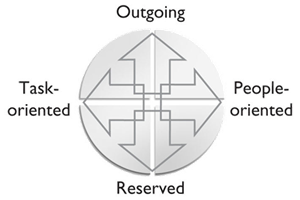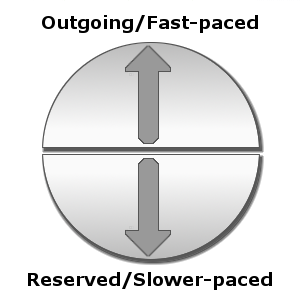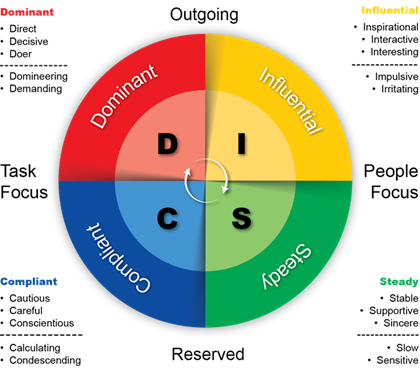
What is the DISC “Steady” Behavioral Personality Style?

People with the Steady DISC Behavior Style are Slower-paced and People-oriented.
They are stable and predictable. They emphasize cooperation with others to carry out tasks and prefer to work as part of a team rather than alone.
Steady-style people are even-tempered, friendly, sympathetic to others, and very generous with loved ones.
Steady Personality Type cross-reference
- Keirsey Type – Artisans
- Temperament Type – Sanguine
- Animal Type – Golden Retriever
- Socio-Communicative Type – Amiable
- True Colors – Orange
- Color Code – Yellow
- Personality Compass – South
- Occupational Type – Conventional
- Leadership Type – Accommodator
MBTI Personality Types (xSxP) – Sensing and Perceiving
Enneagram Types
- Type 2 – The Helper (ESFP, ISFP)
- Type 6 – The Loyalist (All Sensing)
- Type 7 – The Enthusiast (ESTP, ESFP)
- Type 9 – The Peacemaker (ISFP)
What is the DISC Behavioral Model?
The DISC Behavioral Model describes an individual’s characteristics, communication preferences, and motivation as observable behaviors.
Recognizing observable behaviors in others can help you communicate more effectively and build stronger relationships, personally and professionally.
Dr. William Marston theorized that people are motivated by two key motivators that direct human behavioral patterns: the Motor Drive (or Pace Driver) and the Compass Drive (or Priority Driver).
The Motor/Pace Driver
If you divide a circle in half horizontally, the upper half represents outgoing or fast-paced people. The lower half represents reserved or slower-paced people.

Outgoing people tend to move fast, talk fast, and decide quickly.
Reserved people tend to speak more slowly and softly and generally prefer to consider things carefully and thoroughly before deciding.
Remember that these descriptions of behaviors are tendencies rather than absolutes. Depending on the situation, most people will exhibit a bit of both of these Traits.
Even so, most people will exhibit more of one Trait over the other – even if it is slightly more.
The Compass/Priority Driver

Now, divide the circle vertically. The left half represents task-oriented people, and the right represents people-oriented individuals.
Task-oriented people focus on logic, data, results, and projects.
People-oriented individuals focus on experiences, feelings, relationships, and interactions with others.
The Four DISC Behavioral Styles
When you combine the drawings for the Motor and Compass drives, you get the circle of expected behaviors and perspectives divided into four quadrants.

The DISC circle represents the full graphical description of what is commonly referred to as The DISC Model of Human Behavior.
Each quadrant of the DISC circle has descriptive words attached to it.
These descriptive words attempt to capture the typical behavior traits or tendencies people exhibit with the combination of motor and compass drives corresponding to that quadrant.
They are often called a behavioral type or style to make discussing the quadrants easier.
While using the phrase “personality type” with this model is not strictly or technically accurate from a clinical psychology standpoint, it is often used in everyday conversation.
So, the term Behavioral Style is preferred because it more accurately fits the model and its theory.

Learn more about the DISC Behavioral Personality Styles.
Personality Temperaments, Traits, and Types
Personality Temperaments, Personality Traits, and Personality Types are used in Psychology to discuss a person’s Personality, a collection of Emotions, Perceptions, and Actions that interact with each other, regulate themselves, and shape a dynamic system that forms a person’s Behavioral Patterns.
Your inherited traits (your personality Temperance) and acquired traits (such as education, socialization, and other various pressures and aspects) form your Personality.
A Personality Type identifies a specific collection of Traits, both learned and natural, that comprise a broad, general Personality Classification—a way of labeling a collection of traits and behaviors.
A Personality Trait remains consistent and stable over time, which means you exhibit the same pattern across different situations and throughout your life.
Three criteria characterize Personality Traits: (1) consistency, (2) stability, and (3) individual differences. For example, if you are talkative at home, you also tend to be talkative at work. And if you were talkative at age 20, you would still be chatty at age 40.
Personality Temperament is your “Naturally Intuitive” biological Trait. These Traits are partly inherited from your genes and partially determined by your brainstem, which doesn’t change throughout your life. These are Natural Traits regarded as innate or inborn and not learned.
Your Personality Temperament is formed as an infant and is hard to modify, manipulate, or change because it is genetic. In some way or another, your inherited behavioral tendency will always be there.
Personality Traits are quantitative differences between people, and Personality Types are qualitative differences between people. The most crucial difference between the Trait Theory and the Type Theory is that the Type Theory views people’s characteristics as discrete categories. In contrast, the Trait Theory views these characteristics as a continuum.
For example, while a Type Theorist would claim that introverts and extraverts are two types of people, a Trait Theorist claims that extraversion is a gradient, and individuals can fall somewhere in the middle.
Your Temperaments, along with acquired Traits, form your Personality.
Traits
- Conservative
- Loyal
- Cooperative
- Predictable
- Deliberate
- Passive
- Patient
- Systematic
- Reliable
Motivation
- Safety and security.
- Feelings of self-worth and respect.
- They are shown recognition and appreciation.
Steady people genuinely appreciate recognition for their loyalty and dependability.
Annoyances
- Pushiness
- Instability
- Inflexibility
- Anger
- Disloyalty
- Insensitivity
- Pride
- Discrimination
- Unfairness
Under pressure
- Fearful
- Insecure
- Subservient
- Withdrawn
Weaknesses
Steady people like to get into a secure routine and stick with it, resulting in opposition towards change.
Because they are passive and avoid conflict, they may also hold grudges when they experience frustrations and resentments instead of facing the issue head-on.
They strive for positive environments and relationships and can be especially sensitive regarding criticism.
Steady people want to please others and may struggle to say “No” or establish priorities.
They fear security loss through change because they strive for stability, peace, and safety.
Team Value
- They are instinctive relaters and make others feel like they belong.
- They buy into team goals and identify strongly with the team.
- They provide stability and specialized skills and consider the elements of a total project.
- They are sincere, practical, realistic, dependable, loyal, and even-tempered.
- They are focused and intuitive about people and relationships.
- They show patience with others and strive to build relationships.
Ideal Environment
Steady people want to avoid conflict and exist in peaceful environments and around groups that are in harmony.
They flourish in a team environment when working with others and getting along.
Steady people enjoy people but prefer individuals and groups they trust and feel comfortable around.
They like environments with little change or surprise and little to no conflict.
Steady-style people like tasks that can be completed at once or followed through from beginning to end and enjoy practical procedures and systems.
They adjust best when given a long enough period to adapt to change and require an explanation of why the change occurs.
Leadership Style
They tend to take a “participatory” approach emphasizing delegation, listening, and support.
- People who seem shy but demonstrate a tremendous ability to influence others.
- They tend to be soft-spoken and easygoing.
- They don’t like to offend anyone and work hard to keep everyone happy.
- However, their sensitive leadership skills make them effective at getting groups to move out in unity.
Follower Traits
- Do not make quick decisions.
- Like leaders who are understanding and gentle.
- They want to establish a relationship with a leader who will be around for a long time.
- They are concerned about service and stability.
- Sensible and slow judgment is their trademark.
- Like familiar and low-key environments.
Communication Styles
Steady People
- Try to be kind, but don’t overdo it.
- Be strong, if necessary, but be sensitive.
- They are often quiet and seldom initiate conversation.
- And they tend not to make quick decisions.
Dominate People
- Be confident and sure of yourself.
- Challenge them, but not too hard.
- They like to debate.
Influence People
- Be interested and enthusiastic about what they are saying.
- Share your thoughts and concerns.
Compliant People
- Be ready for questions and try to give concrete answers.
- Don’t condemn their doubts.
- They will pressure you with logic.
Teaching Style
- They like to teach steadily and step-by-step.
- They are thorough explanations.
- Their simple but insightful instruction often lacks excitement.
- They need to be more animated.
- They are systematic researchers.
- They are concerned about harmony and accuracy.
- They can be too sweet and slow to share why something is true.
- They should strive to be more interested in results than relationships and revelation.
Learning Styles
Kinesthetic Learner
- They want to FEEL comfortable and secure as they learn.
- Responds best to status-quo-type learning without surprises or challenges.
- It desires that everyone learn harmoniously and together as a family.
- They need to feel the lesson personally and privately.
Visual Learner
- Wants to SEE the lesson through the presenter’s life.
- They learn best by visualizing the study as part of a small group rather than having to be upfront presenting.
- Desires steady and stable visual environments.
Auditory Learner
- LISTENS best to sweet and soft presentations.
- Doesn’t like solid or fast-paced communication.
- Responds best to supportive and security-oriented words.
- Desires to hear lessons in small groups.
- They want to listen to words that make the lesson kind, friendly, and caring.



